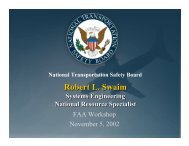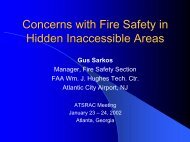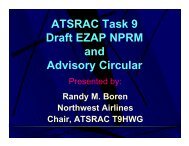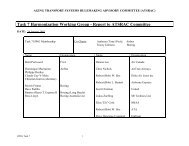- Page 1 and 2: Airport Capacity Benchmark Report 2
- Page 3 and 4: −−The optimum rate is defined a
- Page 6: Table 1Capacity Benchmarks for Toda
- Page 9 and 10: $7/± $WODQWD+DUWVILHOG,QWHUQDWLRQD
- Page 11 and 12: $7/± $WODQWD+DUWVILHOG,QWHUQDWLRQD
- Page 13 and 14: $7/± $WODQWD+DUWVILHOG,QWHUQDWLRQD
- Page 15 and 16: %:,± %DOWLPRUH:DVKLQJWRQ,QWHUQDWLR
- Page 17 and 18: %:,± %DOWLPRUH:DVKLQJWRQ,QWHUQDWLR
- Page 19 and 20: %:,± %DOWLPRUH:DVKLQJWRQ,QWHUQDWLR
- Page 21 and 22: %26± %RVWRQ/RJDQ,QWHUQDWLRQDO$LUSR
- Page 23 and 24: %26± %RVWRQ/RJDQ,QWHUQDWLRQDO$LUSR
- Page 25 and 26: %26± %RVWRQ/RJDQ,QWHUQDWLRQDO$LUSR
- Page 27 and 28: CLT - Charlotte Douglas Internation
- Page 29 and 30: CLT - Charlotte Douglas Internation
- Page 31 and 32: CLT - Charlotte Douglas Internation
- Page 33 and 34: 25'± &KLFDJR2+DUH,QWHUQDWLRQDO$LUS
- Page 35 and 36: 25'± &KLFDJR2+DUH,QWHUQDWLRQDO$LUS
- Page 37 and 38: 25'± &KLFDJR2+DUH,QWHUQDWLRQDO$LUS
- Page 39 and 40: &9*± &LQFLQQDWL1RUWKHUQ.HQWXFN\,QW
- Page 41 and 42: &9*± &LQFLQQDWL1RUWKHUQ.HQWXFN\,QW
- Page 43 and 44: &9*± &LQFLQQDWL1RUWKHUQ.HQWXFN\,QW
- Page 45 and 46: DFW - Dallas-Fort Worth Internation
- Page 47 and 48: DFW - Dallas-Fort Worth Internation
- Page 49: DFW - Dallas-Fort Worth Internation
- Page 53 and 54: 101112131415161718192021DEN - Denve
- Page 55 and 56: DEN - Denver International AirportS
- Page 57 and 58: '7:± 'HWURLW0HWUR:D\QH&RXQW\,QWHUQ
- Page 59 and 60: '7:± 'HWURLW0HWUR:D\QH&RXQW\,QWHUQ
- Page 61 and 62: '7:± 'HWURLW0HWUR:D\QH&RXQW\,QWHUQ
- Page 63 and 64: HNL - Honolulu International Airpor
- Page 65 and 66: HNL - Honolulu International Airpor
- Page 67 and 68: HNL - Honolulu International Airpor
- Page 69 and 70: IAH - Houston-George Bush Intercont
- Page 71 and 72: IAH - Houston-George Bush Intercont
- Page 73 and 74: IAH - Houston-George Bush Intercont
- Page 75 and 76: LAS - Las Vegas International Airpo
- Page 77 and 78: LAS - Las Vegas International Airpo
- Page 79 and 80: LAS - Las Vegas International Airpo
- Page 81 and 82: LAX - Los Angeles International Air
- Page 83 and 84: LAX - Los Angeles International Air
- Page 85 and 86: LAX - Los Angeles International Air
- Page 87 and 88: MEM - Memphis International Airport
- Page 89 and 90: MEM - Memphis International Airport
- Page 91 and 92: MEM - Memphis International Airport
- Page 93 and 94: MIA - Miami International AirportAi
- Page 95 and 96: MIA - Miami International AirportSc
- Page 97 and 98: MIA - Miami International AirportSc
- Page 99 and 100: MSP - Minneapolis-St. Paul Internat
- Page 101 and 102:
MSP - Minneapolis-St. Paul Internat
- Page 103 and 104:
MSP - Minneapolis-St. Paul Internat
- Page 105 and 106:
EWR - Newark International AirportA
- Page 107 and 108:
EWR - Newark International AirportS
- Page 109 and 110:
EWR - Newark International AirportS
- Page 111 and 112:
JFK - Kennedy International Airport
- Page 113 and 114:
JFK - Kennedy International Airport
- Page 115 and 116:
JFK - Kennedy International Airport
- Page 117 and 118:
LGA - New York LaGuardia AirportAir
- Page 119 and 120:
LGA - New York LaGuardia AirportSch
- Page 121 and 122:
LGA - New York LaGuardia AirportSch
- Page 123 and 124:
MCO - Orlando International Airport
- Page 125 and 126:
MCO - Orlando International Airport
- Page 127 and 128:
MCO - Orlando International Airport
- Page 129 and 130:
PHL - Philadelphia International Ai
- Page 131 and 132:
PHL - Philadelphia International Ai
- Page 133 and 134:
PHL - Philadelphia International Ai
- Page 135 and 136:
PHX - Phoenix Sky Harbor Internatio
- Page 137 and 138:
PHX - Phoenix Sky Harbor Internatio
- Page 139 and 140:
PHX - Phoenix Sky Harbor Internatio
- Page 141 and 142:
PIT - Pittsburgh International Airp
- Page 143 and 144:
PIT - Pittsburgh International Airp
- Page 145 and 146:
PIT - Pittsburgh International Airp
- Page 147 and 148:
SLC - Salt Lake City International
- Page 149 and 150:
SLC - Salt Lake City International
- Page 151 and 152:
SLC - Salt Lake City International
- Page 153 and 154:
SAN - San Diego International Airpo
- Page 155 and 156:
SAN - San Diego International Airpo
- Page 157 and 158:
SAN - San Diego International Airpo
- Page 159 and 160:
SFO - San Francisco International A
- Page 161 and 162:
SFO - San Francisco International A
- Page 163 and 164:
SFO - San Francisco International A
- Page 165 and 166:
SEA - Seattle-Tacoma International
- Page 167 and 168:
SEA - Seattle-Tacoma International
- Page 169 and 170:
SEA - Seattle-Tacoma International
- Page 171 and 172:
STL - Lambert St. Louis Internation
- Page 173 and 174:
STL - Lambert St. Louis Internation
- Page 175 and 176:
STL - Lambert St. Louis Internation
- Page 177 and 178:
TPA - Tampa International AirportAi
- Page 179 and 180:
TPA - Tampa International AirportSc
- Page 181 and 182:
TPA - Tampa International AirportSc
- Page 183 and 184:
IAD - Washington Dulles Internation
- Page 185 and 186:
IAD - Washington Dulles Internation
- Page 187 and 188:
IAD - Washington Dulles Internation
- Page 189 and 190:
DCA - Washington-Ronald Reagan Nati
- Page 191 and 192:
DCA - Washington-Ronald Reagan Nati
- Page 193 and 194:
DCA - Washington-Ronald Reagan Nati
- Page 195:
Operations, Enplaned Passengers, an
















